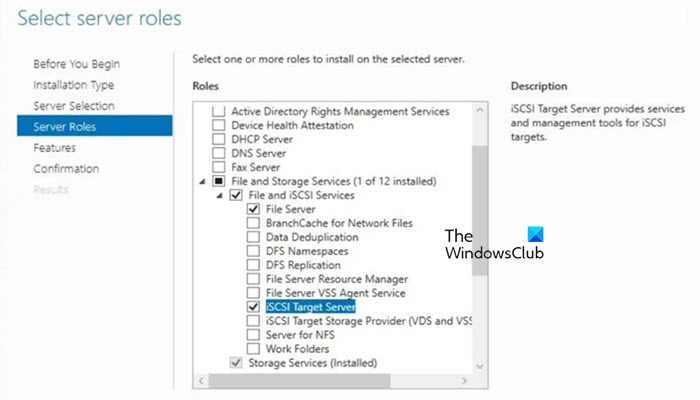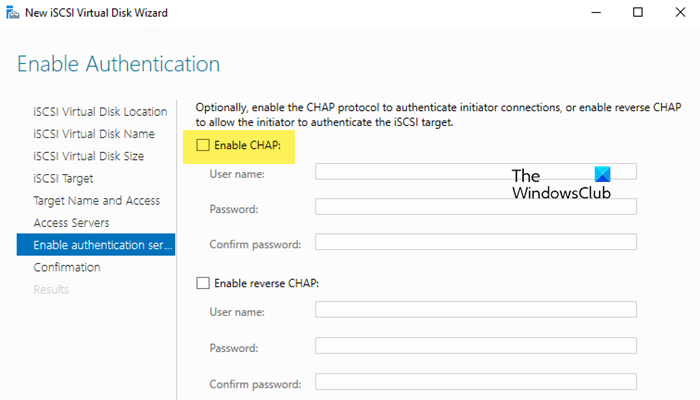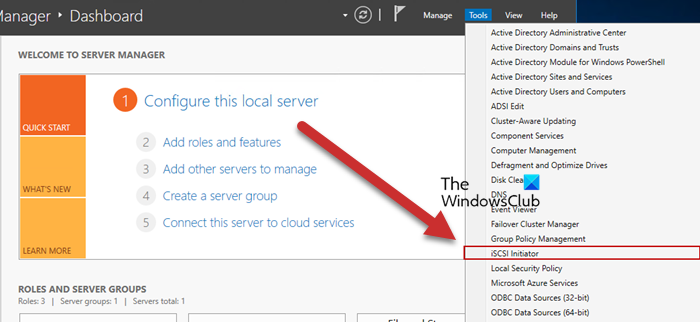Setting up an iSCSI Target is easy to configure a network-based storage server. It allows remote devices to access and use storage over a TCP/IP network. In this guide, we will walk through the process of installing and configuring an iSCSI Target on the storage server, so stay with us until the end.
How to install and use iSCSI Target to configure Storage Server
If you want to learn how to install and use iSCI Target to configure Storage Server, follow these steps:
- Install the iSCSI Target server
- Configure the iSCSI Target server
- Configure the iSCSI Initiator
Let’s get this guide on the road.
1] Install the iSCSI Target Server

Windows Servers come with a built-in feature called the iSCSI Target Server Role. This role enables the Windows server to act as a centralized storage provider, so we will enable this role. Here’s how to do it.
- Launch Server Manage, go to the Manage tab, select the Add Roles and Features option, and hit the Next button.
- In the Select Installation Type window, select the Role-based or feature-based installation option, and click the Next button.
- The next step is to select a server where the iSCSI Target will be installed, so click on Select a server from the server pool, then click on the Next button.
- Now, in the Select Server Roles section, expand File and Storage Services, then expand File and iSCSI Services, tick the box for iSCSI Target Server, and select the Next button.
- In the Feature window, click Next to finish the installation. Once you’ve done this, hit the Close button.
Wait for it to complete installation; once done, move to the next step.
2] Configure the iSCSI Target server

Once the feature is installed, the next steps include configuring the iSCSI Target Server. In this step, we will set up a server providing block-level storage over a network using the iSCSI protocol. Follow the steps mentioned below to configure the iSCSI Target server.
- First, create the iSCSI target folder in any directory or partition of your choice.
- Launch the Server Manager, click on File and Storage Services from the dashboard, and select the iSCSI option.
- To create an iSCSI Virtual Disk, click on the “To Create an iSCSI virtual disk, start the New iSCSI Virtual Disk Wizard” link. Alternatively, in the same window, users can also expand the Tasks menu, and select New iSCSI Virtual Disk option.
- In the next window, click on Select by volume, and then select Type a custom path, and browse the folder we created earlier.
- Once typed in, hit the Next button, give it a name, add the description, and then click the Next button again.
- Then, specify the size of the iSCSI virtual disk and select one of the three options for managing and allocating the storage, keeping in mind your needs.
- Hit the Next button. The next step is to configure the iSCSI Target, so in the next window, click on New iSCSI Target.
- Type in the Target name and description, hit the Next button, and then click on the Add button to specify the iSCSI initiators. Then, select Enter a value for the selected type in the Add Initiators ID window.
- Expand the Type drop-down menu, select IP Address, add the initiator IP Address, and hit the Ok button.
- The next step is to configure CHAP (Challenge-Handshake Authentication Protocol) for added security between the iSCSI target and initiators. Select either one of the two options and click on Next.
- Lastly, review the configuration and complete the Wizard by hitting the Complete button.
The iSCSI virtual disk will now be created and the target is ready.
3] Configure the iSCSI Initiator

After configuring the iSCSI target on the server, the next step is configuring the client (iSCSI Initiator). The iSCSI Initiator is responsible for establishing a connection to the iSCSI Target, allowing a client to access its storage resources.
Here’s how to configure the iSCSI initiator.
- Launch Server Manager, go to the Tools bar, select iSCSI Initiator, and hit Yes to the prompt.
- In the iSCSI Initiator Properties window, navigate to the Targets tab, enter the IP Address of the iSCSI target server, and hit the Quick Connect button to discover the target.
- Once the target is discovered, select it and click Connect.
- The next step is to set up authentication, so click on the Advanced option, check the CHAP box, and enter the credentials.
- Hit the Enter and OK keys to end the connection process.
- Once connected, the iSCSI disk should appear in Disk Management. However, it will be showing offline and uninitialized, so right-click on it and select Online.
- Once done, again right-click on it and select Initialize Disk.
- Now, please right-click on the unallocated space of the new disk, select New Simple Volume, and follow the New Simple Volume Wizard to assign a drive letter, format the volume, and label it.
After formatting, the disk is ready to use.
How do I add an iSCSI to my server?
To add iSCSI to the server, the first step is to install the iSCSI Target server, create a storage volume, and define it as a Target server. Then, configure the network setting and allow initiators to connect.
Read: Add Group Policy Management Console in Windows Server
What is the difference between iSCSI Target and Initiator?
The iSCSI Target is the storage device (server) that provides storage resources over a network. The iSCSI Initiator is the client that connects to the Target to access and use that storage as if it were locally attached. In short, the Targets provide the storage, and the Initiator uses it.
Also Read: Best Windows Server Tutorial and Tips.
Leave a Reply